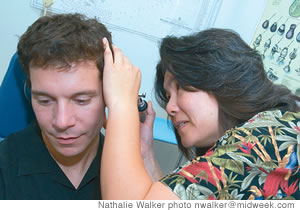When They’re All Head Cases
Interviewed by Melissa Moniz
Wednesday - October 31, 2007
E-mail this story | Print this page | Comments (0) | Archive
 Del.icio.us Share
Del.icio.us Share

|
What is otolaryngology?
An otolaryngologist addresses the medical and surgical problems of the head and neck region and is commonly known as an ear, nose, and throat specialist. Otolaryngology also includes head and neck surgery, sinus surgery, and facial plastic and reconstructive surgery.
How long have you been practicing otolaryngology?
I’ve been an otolaryngologist in Kailua for about 10 years.
What are some of the most challenging cases?
Every case is a challenge! Otolaryngology covers a broad range of surgery including microscopic surgery on the ear, endoscopic sinus surgery, long, complicated head and neck surgeries to remove cancer, and delicate facial plastic surgery. One of the most challenging surgeries to do well is repair of a cleft lip.
How many of the surgeries you do are cosmetic and how many are medical?
The majority of surgery in otolaryngology is to correct or improve a medical problem such as obstructive sleep apnea, chronic sinusitis or ear infections. Some of the facial plastic surgery such as eyelid surgery and face lifts would usually be considered cosmetic.
What are the most common cases that you treat?
Common problems that otolaryngologists deal with include ear infections, sinus infections, cancer in the head and neck area, allergy, sleep apnea and voice disorders.
Are your patients primarily children or adults?
Otolaryngologists are fortunate in that patients include males and females of all age groups. In my practice, 30-35 percent are children because I sub-specialize in pediatric otolaryngology.
Is there a difference working with children and adults?
Children are more likely to have problems such as recurrent infections in the ears, nose and throat, while adults are more likely to see an otolaryngologist for sinusitis, vertigo, sleep apnea, head and neck tumors, and voice problems. Adults are also more likely to have illness related to their lifestyles such as diabetes, cancer and obesity.
What is most rewarding about what you do?
The most rewarding part of my job is meeting and working with an incredible group of clients/patients every day. Often, I learn more from my patients than I teach them. Having the opportunity to help someone feel better, hear better or breathe better is also a reward in itself.
How much of your time is spent in the office and how much is spent in the operating room?
I spend one morning each week in the operating room at Castle Medical Center, and the rest of the week is in my office seeing patients and performing minor procedures. Evenings and weekends are used for paperwork!
Which surgical procedure involves the most time?
Surgery to remove cancer in the head and neck area can take a significant amount of time. First, surgery to remove the cancer and preserve function can be difficult. Then, surgery to reconstruct the area can be as or more difficult. Some cancer surgeries may be more than 12 hours long.
How many patients do you have, and how many do you see in an average week?
In 10 years we have seen more than 10,000 patients. In an average week we see 80 to 100 patients.
What is your specialty area?
Although my sub-specialty training is in facial plastic and reconstructive surgery, and pediatric E.N.T., my Kailua practice includes a good variety of all of otolaryngology. When I travel with the Aloha Medical Mission group, I specialize in cleft lip and cleft palate surgery.
Are there any recent medical advancements that have helped with your work?
There have been many advancements in otolaryngology. Coblation tonsillectomy techniques result in less pain and faster healing after surgery; cochlear implants can help those with profound hearing loss; better instruments and camera equipment have made sinus surgery safer; office procedures are available for reducing snoring; and newer non-surgical treatments to reduce facial wrinkles and promote collagen remodeling are just a few of the advancements available.
For someone considering cosmetic surgery, what should they know before getting the procedure done?
First, what is the goal? Is the goal to look better, correct a problem or look younger? Once a person knows what he or she is trying to achieve, it is easier to discuss how to reach this goal with the facial plastic surgeon. Second, seek out more than one opinion. Third, find a surgeon who understands the problem and can offer surgical and nonsurgical options.
What is the most common cosmetic procedure request?
Botox treatment of “frown lines” is very popular and can be done with minimal down time and excellent patient satisfaction.
How frequently do see Botox patients?
Botox treatments last three to six months, depending on a person’s muscle thickness, amount of facial expression and, sometimes, how many times they have had Botox before.
E-mail this story | Print this page | Comments (0) | Archive
Most Recent Comment(s):













